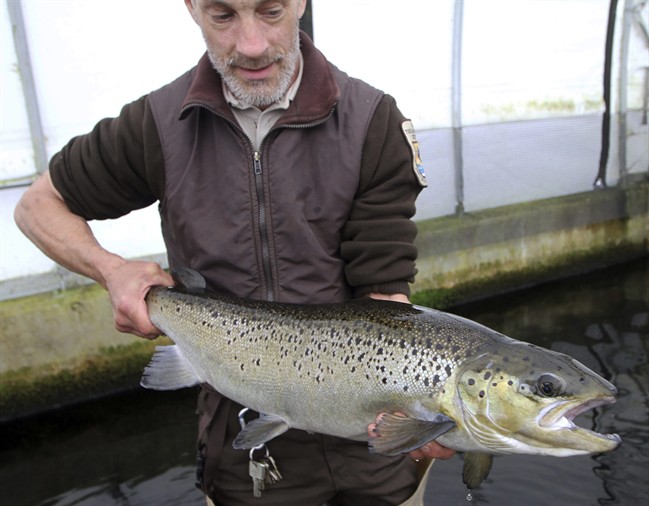Liberal governments in Ottawa and St. John’s are in a power struggle over the province’s fast-dwindling wild salmon.

Newfoundland and Labrador’s salmon population has declined by 45 per cent since 2015, according to an Atlantic Salmon Federation report this month.
The province, which wants more control over the recreational salmon fishery, for the first time this year set its own catch-and-release limits, on top of Ottawa’s.
But the federal and provincial limits aren’t in synch – the feds have a three-fish-a-day limit, while the province is allowing 10 fish up to July 20. Both allow fishermen to keep a single salmon.
The province says its first-ever limit is intended to preserve more fish.
READ MORE: Number of wild Atlantic salmon drops for second straight year
But the move has unnerved some conservationists, who see an inherent risk in allowing the provincial government to override the federal Department of Fisheries and Oceans’ (DFO) environmental consultation process when setting limits.
“The stakes are high for wild salmon,” said Steve Sutton of the salmon federation. “DFO needs to be managing this type of fishery, the province is just not equipped to do it and they never will be.”
The federation was happy with the federal limit, arguing that catch and release is an important conservation technique. But Sutton says the provincial regulations are more about political power than conservation.
“This is not really about conservation, there was a long, science-based open process that led to a solid conservation plan from DFO in May,” said Sutton. “This is spiteful and reactionary on the part of the province.”
Provincial Fisheries Minister Gerry Byrne said the province should co-chair salmon consultations, but Ottawa hasn’t responded appropriately to his requests for involvement. He said he was not given access to a salmon advisory committee meeting hosted by DFO, even after he requested an invitation.
The season began several days late this year after multiple printing errors on the licences – mistakes Byrne attributed to federal disorganization.

Get breaking National news
Byrne said the rocky start to the season represents “anything but a successful collaborative relationship” with Ottawa on salmon.
“I am very, very critical of the Department of Fisheries and Oceans, not only about how they handled this 2018 season, but the past 2017 season as well,” said Byrne.
Byrne says the provincial limit is in line with DFO’s standards.
In an e-mailed statement, DFO said only the “management decision on Atlantic salmon has not changed. As announced on May 7th, it remains a three catch and release limit per day and a one fish retention until in-season review in July.”
WATCH: 1,000 Atlantic salmon are back in their natural habitat — N.B.’s Fundy National Park

Byrne told The Canadian Press the two catch-and-release limits are neither confusing nor contradictory, and anglers fully understand the law.
“If you caught your eleventh fish on the fourth day, you would be in violation of the provincial Wildlife Act,” said Byrne.
But Terry Byrne, who manages the Flowers River Lodge in Labrador, said the 10-fish limit has some customers considering cancelling their trips this summer. He called this year’s salmon plan “a complete disaster.”
“I’m hoping and praying that Minister Byrne and Premier (Dwight) Ball realize the error of their ways and get over this petty vindictive politics and make a decision based on conservation for the good of all,” said Terry Byrne.
The federal limits has been criticized by some anglers who prefer to keep their fish, expressing concern that allowing catch-and-release anglers to catch more fish is unfair and unbalanced.
A group of anglers called the Citizens Outdoor Rights Alliance held a public meeting in Deer Lake last month, saying they would prefer no licences be issued if the salmon population is in enough danger to warrant a one-fish retention limit.
A June 11 report from the salmon federation says the number of salmon in North American rivers dropped for the second year in a row.
WATCH: Halt on commercial salmon fishing in Greenland to help grow shrinking North American population

It says numbers in 2017 dipped overall by 15 per cent compared to the year before, and that only half of the 84 rivers assessed in North America met the minimum conservation limit required to safely sustain the species.
A further 22 of those rivers had fewer than half of the required number of spawning salmon.
Newfoundland and parts of southern Labrador experienced the biggest decline, with their number of returning wild Atlantic salmon falling 45 per cent since 2015.
Gerry Byrne maintains the province’s first-time limit was entirely based on conservation principles, and thinks the reduced price for licences this year, to $5 from $25, will put more people on the water to play the regulating role of catch and release fishing.
“If you’re a true conservationist you will adhere to the limitations on hook and release,” Byrne said.
He said his government is the “principal enforcement agency” on the rivers, although he’s asked the federal government to put more resources into enforcement.
“I’ve asked for the federal government to become more actively engaged in either policing and protecting inland fisheries and inland waters, or if they don’t have an interest in doing that, to provide province of Newfoundland and Labrador with financial resources to do their job for them. So far they’ve done neither.”







Comments